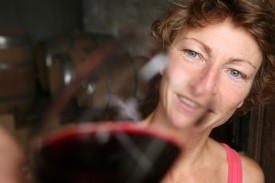In a December wine note I wrote about the plight of Burgundian winemaker Emmanuel Giboulot who was being put on the rack by the French Ministry of Agriculture for his refusal to spray his vines against the potentially very dangerous and infectious vine disease known as flavescence dorée. Well, Farmer Giboulot had his day in court earlier this week, and it could have been worse. The prosecution recommended a 1,000 euro fine with half of it suspended. Presumably there will be some conditions attached to the suspended 500 euros, but we won’t know that until April when the judge renders her verdict.

There is some suspicion that the more than half million signatures collected on the “Declaration of Support for Emmanuel Giboulet” wherein signatories encourage the beleaguered defendant to “be proud of the fine example you have set for all the farmers of France – organic and conventional – and for all citizens with your responsible behavior in the face of threats to the well-being of bees” had a material effect in the relatively lenient sentencing recommendation.
It seems that Giboulot, to his credit, took the high road in making his objection to the spraying known and bringing it to public attention. The act governing mandatory spraying require that farmers show a bill of sale proving that they have bought the pesticide (the disease is spread via a flying insect), but there’s no mechanism in place to ensure that it has actually been applied. For some observers, however, Giboulot’s actions in putting himself in the sights of the authorities amounts to recklessness. The suspicion is that many winegrowers may have disposed of the chemical in some way rather than apply it to their vines – a dubious practice in any case by individuals who believe the chemical may be dangerous to the environment.
Those who have a mind to can sign and submit the petition in support of Giboulot here and tick a box that will ensure you hear via email how the court case plays out.
* * * *

We have a number of wines in the shop made either wholly or with a significant proportion of carignan these days and they happen to be wines I really like. The thought occurs that perhaps I have become a carignan fan without quite being aware of it. The grape does not have a high reputation, mainly because in the Languedoc, where it is very widely planted, it has been the major component in most of that area’s bulk red wines and therefore implicated by association with the over-production problem that is endemic there. Over the last 30 years half of its total acreage has been grubbed up in EU vine-pull schemes.
The wines I’m thinking of are the Vignoble Reveille Climax (75%), Domaine Ledogar La Mariole (mostly carignan- and from 120 year-old vines at that) and Chateau d’Oupia’s amazin’ little $11 over-performer, Les Heretiques (100%).
The author of the OCW’s entry on the vine has little good to say of it: Its wine is high in everything—acidity, tannins, colour, bitterness—but finesse and charm. This gives it the double inconvenience of being unsuitable for early consumption yet unworthy of maturation. The vine is not even particularly easy to grow. It is extremely sensitive to powdery and downy mildew, prone to rot, and prey to infestation by grape worms. Its bunches keep such a tenacious hold on the vine that it does not adapt well to mechanical harvesting, but then the majority of Carignan is not trained on wires anyway but grows in gnarled old bushes that do not share the stability of grenache.
Perhaps because of its post-phylloxera popularity as a pisser (high-yield variety, see below), there are quite a few plots of very old vine carignan out there waiting for someone to take them in hand and some feeling among Laguedociens that this vine may by now be more of a native than grenache, syrah, and mourvedre – a threesome that are thought of improving varieties in the region (but are more properly associated with the Rhone) and with which carignan is frequently and successfully blended. I was pleased to find a video of winemaker Jon Bowen of Domaine Sainte-Croix in Fraïssé des Corbières at the border of the Aude and Crispeels’ Pyrénées-Orientales in which he talks about his fascination for the maligned grape. View it here, and tell me if his enthusiasm isn’t just a little bit infectious.
Foreign phrase of the week: Faire pisser les vignes – To derive the maximum yield from vines; to generate quantity at the expense of quality.
That’s it for now.
-Stephen